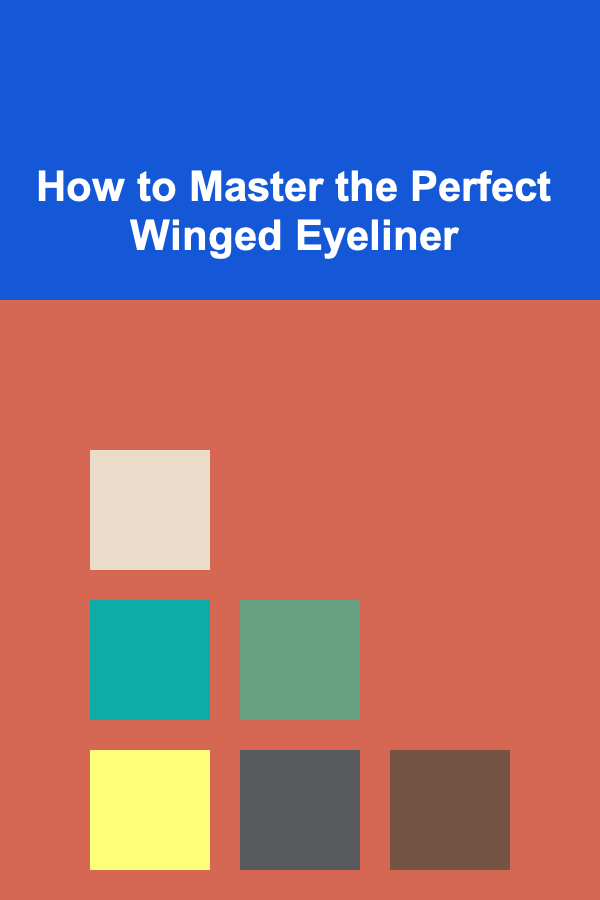
How to Master the Perfect Winged Eyeliner
ebook include PDF & Audio bundle (Micro Guide)
$12.99$10.99
Limited Time Offer! Order within the next:

Winged eyeliner is a timeless and versatile makeup look that can be adapted for any occasion, from a casual day out to a glamorous evening event. It can enhance your eye shape, add drama, and even make your lashes appear fuller. However, mastering the perfect winged eyeliner can feel like a daunting task, especially for those who are new to makeup or struggle with steady hands. With the right techniques, tools, and a little practice, anyone can achieve the perfect winged eyeliner.
In this article, we will break down the steps for mastering winged eyeliner, the best products to use, tips for different eye shapes, and ways to overcome common mistakes. Whether you prefer a subtle flick or a bold cat-eye, we'll guide you through the process to help you create your ideal winged eyeliner.
Understanding the Basics of Winged Eyeliner
Before diving into the technique, it's important to understand the basic concept of winged eyeliner. Winged eyeliner is essentially eyeliner that extends beyond the outer corner of the eye in a diagonal line, creating a "wing" that can range from subtle to dramatic. This look works for any eye shape and can be customized to suit your style, whether you're aiming for a natural everyday look or a bold, dramatic statement.
There are several types of winged eyeliner looks to consider:
- Classic Wing: A simple, clean wing that's perfect for everyday wear.
- Cat Eye: A more exaggerated wing with a thicker line and a sharper angle.
- Flicked Liner: A smaller, more subtle wing for a hint of elegance without overdoing it.
- Double Wing: A daring look with two wings extending from the outer corner of the eye, often paired with bold makeup.
Choosing the Right Eyeliner
To achieve a perfect winged eyeliner, selecting the right eyeliner formula and tool is essential. There are several options available, each with its own advantages and challenges. Here's a breakdown of the most common types of eyeliners:
2.1 Liquid Eyeliner
Liquid eyeliner is the most popular choice for creating sharp, defined wings. It typically comes with a fine-tip applicator or a brush, allowing you to draw precise lines. Liquid eyeliners tend to have long-lasting formulas that stay in place throughout the day, making them ideal for creating a dramatic wing. They are available in both matte and glossy finishes.
Best for: Defined, long-lasting wings.
2.2 Gel Eyeliner
Gel eyeliner is a creamy formula that comes in a pot or jar and is typically applied with an angled brush. It provides a smooth finish with the intensity of liquid liner but can be more forgiving in terms of blending and smudging. Gel liners tend to have a softer finish, making them suitable for a more natural or smoky winged look.
Best for: Soft, blendable finish and customizable intensity.
2.3 Pencil Eyeliner
Pencil eyeliner is the least precise option but can still be used for winged eyeliner. A pencil eyeliner can be sharpened for fine lines, and with the right technique, it can create a less defined, more smudged look. For a winged eyeliner, you may want to use a waterproof pencil eyeliner to prevent smudging.
Best for: A softer, smudged wing or for beginners.
2.4 Felt-tip Marker Eyeliner
Felt-tip markers combine the precision of liquid liners with the ease of application of a pen. These liners usually offer a smooth application with the benefit of precision. Felt-tip eyeliner pens are quick to use and are great for beginners due to their user-friendly design.
Best for: Precision, speed, and beginners.
The Step-by-Step Process of Creating the Perfect Wing
Once you've selected your eyeliner, it's time to perfect the technique. Here's a detailed step-by-step guide on how to master the perfect winged eyeliner:
3.1 Step 1: Prep Your Lids
Before applying any eyeliner, it's important to prepare your eyelids. Start by gently cleansing your face to remove any excess oils or makeup that could affect the eyeliner's application. Apply a primer to your eyelids to create a smooth, even base for the eyeliner to adhere to. If you have oily eyelids, a primer will also help the eyeliner last longer without smudging.
3.2 Step 2: Draw the First Line
Start by drawing a thin line along your upper lash line. Begin at the inner corner of your eye and work your way outward. This line should be as close to your lashes as possible to create a clean base. For beginners, it's recommended to start with a thin line so that you can gradually build up the thickness as you go. A thin line also allows you to make adjustments if necessary.
3.3 Step 3: Create the Wing
The next step is to draw the wing itself. Here's how to approach it:
- Angle: To determine where the wing should go, imagine a line extending from the lower lash line toward the outer edge of your eyebrow. This will help you determine the angle and length of the wing.
- Start from the outer corner: Draw a small diagonal line from the outer corner of your eye. This should be at a 45-degree angle (you can make the wing more dramatic by increasing the angle).
- Connect the Line: Once you've drawn the diagonal line, connect it to the original line along your upper lash line, forming a triangle shape. The point of the triangle will be where the wing ends.
3.4 Step 4: Fill in the Wing
Once the shape of the wing is drawn, it's time to fill it in. Use your eyeliner to fill in the triangle, ensuring that the line is even and smooth. If you have trouble with precision, you can use a Q-tip dipped in makeup remover to clean up the edges and make the lines sharper.
3.5 Step 5: Define the Line
Once the wing is in place, go back to the upper lash line and draw a line to make the eyeliner more defined. You can build up the thickness gradually by adding more product, but it's important to keep the line even and symmetrical on both eyes. For a bolder look, you can make the line thicker as you move toward the outer corner of your eye.
3.6 Step 6: Final Touches
After your wing is complete, take a moment to assess its symmetry. It's important that both wings match in terms of length, angle, and thickness. Use a cotton swab or makeup remover to fix any unevenness.
Finally, apply mascara to your lashes to enhance the look and complete the winged eyeliner. You may also choose to line your lower lash line if you prefer a more dramatic look.
Tips for Perfecting the Winged Eyeliner
Achieving the perfect winged eyeliner can be challenging, but with practice and a few helpful tips, you can create a flawless look every time. Here are some tips to improve your technique:
4.1 Practice Makes Perfect
The key to mastering winged eyeliner is practice. Start with a simple, thin wing and gradually build up the complexity as you become more comfortable. Don't be discouraged by mistakes---every attempt helps you improve.
4.2 Use Tape for Precision
If you're struggling to get a clean wing, you can use a small piece of tape to help create a straight line. Place the tape at an angle from the outer corner of your eye toward the end of your eyebrow. This will act as a guide to create a sharp, defined wing. Simply remove the tape once you're finished applying your eyeliner.
4.3 Make the Wing Gradually Larger
If you're new to winged eyeliner, it's easier to start with a small wing and gradually build it up. This way, you can avoid going too big too quickly, and you can adjust the size as needed.
4.4 Use a Steady Hand
One of the biggest challenges when creating a winged eyeliner is keeping your hand steady. To avoid shaky lines, rest your elbow on a flat surface for support. You can also try leaning your hand against your face for additional stability.
4.5 Fix Mistakes with Concealer
If you make a mistake or the line isn't as sharp as you'd like, don't worry. Use a small brush and some concealer to clean up the edges and make the wing appear sharper. This will help you achieve a more polished look.
Winged Eyeliner for Different Eye Shapes
While winged eyeliner can work for any eye shape, different eye shapes require different approaches. Here are some tips for applying winged eyeliner based on your eye shape:
5.1 Almond Eyes
Almond-shaped eyes are the most versatile when it comes to eyeliner. Most styles of winged eyeliner will work, so you can experiment with different angles, thicknesses, and lengths to create your desired look.
5.2 Hooded Eyes
If you have hooded eyes, the key to winged eyeliner is to keep the line thin and close to the lash line. Avoid drawing a thick line or creating an overly dramatic wing, as it may get lost when your eyes are open. You may also want to experiment with a slightly higher placement of the wing to prevent it from being hidden by the hooded skin.
5.3 Monolid Eyes
For monolid eyes, a winged eyeliner look that extends upward at an angle can help create the illusion of depth. Focus on creating a clean, defined line and avoid making the wing too thick, as it can overwhelm the eye.
5.4 Downturned Eyes
To lift downturned eyes, create a wing that extends upward at a sharper angle. This will help give the eyes a lifted, more open appearance. Ensure the wing is symmetrical and extends outward toward the brow to balance the eye shape.
Common Mistakes to Avoid
While learning how to apply winged eyeliner, there are several common mistakes you should avoid:
- Uneven Wings: Always check the symmetry of both wings before you finish. Even small differences in length or angle can make the wings look unbalanced.
- Overly Thick Lines: Thick eyeliner can overwhelm the eye, especially for beginners. Start with a thin line and build up gradually.
- Smudging: To prevent smudging, use waterproof or long-lasting eyeliner formulas. You can also set the eyeliner with a translucent powder to lock it in place.
- Skipping Mascara: Mascara can help complete the winged eyeliner look by lifting and defining the lashes. Don't skip this step if you want your winged eyeliner to look more polished.
Conclusion
Mastering the perfect winged eyeliner takes practice, patience, and the right techniques. By choosing the right tools, following a step-by-step process, and customizing the look for your eye shape, you can create a flawless wing every time. With time and experimentation, you'll be able to master different types of wings, from subtle flicks to bold cat eyes, and elevate your makeup game to new heights.

How to Create a Wedding Day Packing List
Read More
How To Deal with Anxiety About School
Read More
How To Find Books with Brilliant Character Development
Read More
How to Maximize Your Retirement Savings with IRAs
Read More
How to Transform Your Kitchen with Budget-Friendly Updates
Read More
How to Acquire Basic Copywriting Skills
Read MoreOther Products

How to Create a Wedding Day Packing List
Read More
How To Deal with Anxiety About School
Read More
How To Find Books with Brilliant Character Development
Read More
How to Maximize Your Retirement Savings with IRAs
Read More
How to Transform Your Kitchen with Budget-Friendly Updates
Read More